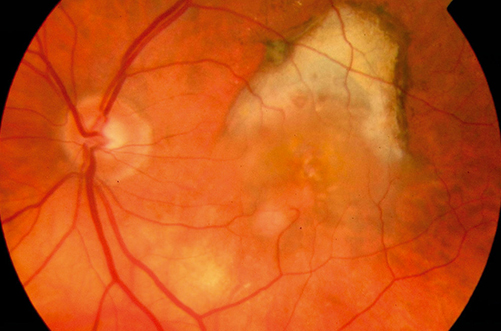Posted by: Eye Centers of Florida in Eye Health
Dry AMD vs. Wet AMD: What’s the Difference?

Age-related macular degeneration (AMD) is the leading cause of blindness in people over the age of 50, affecting approximately 1.8 million Americans — more than cataracts and glaucoma combined. If you’re not familiar with this condition, check out our resource on the subject for more information.
If you have heard of AMD, you might not be aware that there are two different kinds: wet and dry AMD, both affecting your central vision. In both cases, an important structure located in the center of the retina — the macula — begins to break down. With this in mind, there are some important differences between the two.
What is Dry AMD?
Dry AMD makes up about 90% of all cases of AMD. In the early stages, the symptoms start slowly and progress over several years, with vision loss occurring in the mid to late stages. It is called “dry” AMD because there is no leakage of fluid from the eye’s blood vessels.
Dry AMD is characterized by the formation of white or yellowish spots on the retina, called drusen, which cause the macular cells to deteriorate. Dry AMD may also affect only one eye at first, causing the other to overcompensate until it, too, becomes affected.

Signs and Symptoms of Dry AMD
Symptoms of dry AMD include:
- Reduced central vision in one or both eyes
- Visual distortions, such as straight lines seeming curved and colors seeming muted or less bright
- Difficulty adjusting from brighter to lower light, and needing brighter light to accomplish close-up tasks
- Difficulty recognizing faces and reading print

What is Wet AMD?
Nearly all cases of wet AMD begin as dry AMD, but unlike dry AMD, the symptoms of wet AMD may progress over days or weeks instead of years, causing abrupt and permanent vision loss.
In wet AMD, abnormal blood vessels begin to form beneath the retina, which can leak blood and fluid into the eye and damage the cells of the retina, causing scarring, which leads to the loss of vision.
Signs and Symptoms of Wet AMD
- Reduced central vision in the form of a well-defined dark spot in the middle of your sight
- A sudden blurriness or haziness of vision
- Straight lines appearing distorted or bent
- Difficulty adapting from bright to lower light
How does Dry AMD Turn into Wet AMD?
Only about 10% of cases of dry AMD will progress to wet AMD. This is because the growth of abnormal blood vessels in the retina is the body’s misguided attempt to supply more nutrients and oxygen to the struggling macula. Instead, these blood vessels end up bursting and leaking into the retina, causing even more damage.
This is not to say that all cases of wet AMD will start as dry AMD. If you’re experiencing any of the above symptoms — especially if they are sudden and seem to come out of nowhere — it’s important to seek medical help immediately.
Treatment of Wet and Dry AMD
The danger of AMD lies in the fact that symptoms of dry AMD are slow to appear and its ability to rapidly progress from dry to wet AMD can cause permanent vision loss.
There is no cure for AMD, but there are treatments available to halt the progression of AMD, such as vitamin supplements and, in the case of wet AMD, injections to slow the growth of abnormal blood vessels. However, for these treatments to be effective, it’s critical that the disease be detected early, before permanent vision loss can occur.
Treating AMD at Eye Centers of Florida
Our doctors at Eye Centers of Florida are specialized in treating and helping patients manage their AMD. One of those specialists is Board Certified Ophthalmologist, Claudio A. Ferreira, M.D., our retinal surgeon. From his treatment of macular holes, pneumatic retinopexy, and retinal detachments, to his exhaustive research on the retina in general, Dr. Ferreira has become a leading expert in his field. As a member of the team at Eye Centers of Florida, he’s helped countless patients experiencing retinal and macular conditions — like AMD — get the most out of their sight.
We recommend that everyone over the age of 50 receive a comprehensive eye exam every year to check for conditions such as AMD and glaucoma, as early detection is critical for these diseases. Schedule your annual eye exam at Eye Centers of Florida today!